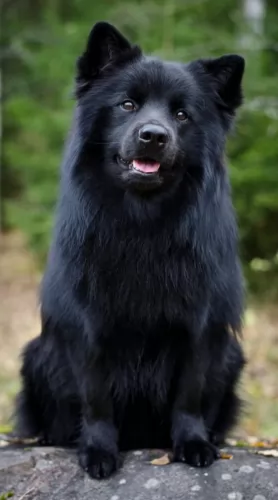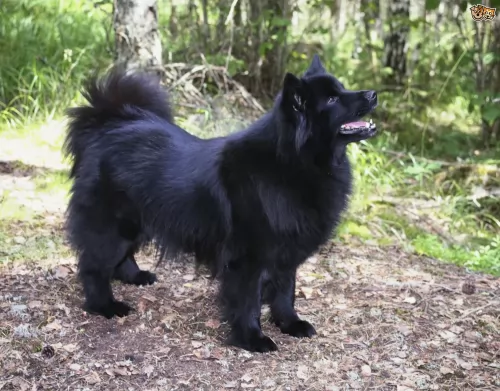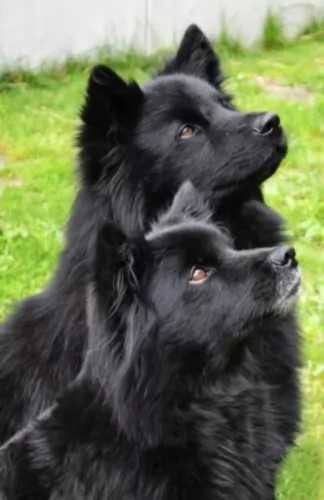 MyDogBreeds
MyDogBreedsSwedish Lapphund is originated from Sweden but Santal Hound is originated from India. Swedish Lapphund may grow 6 cm / 3 inches higher than Santal Hound. Swedish Lapphund may weigh 9 kg / 20 pounds more than Santal Hound. Both Swedish Lapphund and Santal Hound has almost same life span. Both Swedish Lapphund and Santal Hound has same litter size. Swedish Lapphund requires Moderate maintenance. But Santal Hound requires Low maintenance
 This is a Spitz type of dog from Sweden. It is Sweden’s national dog.The dog has always been used for herding and guarding livestock such as reindeer for the Sami people.
This is a Spitz type of dog from Sweden. It is Sweden’s national dog.The dog has always been used for herding and guarding livestock such as reindeer for the Sami people.
The dog is much the same as the Finnish Lapphund, and some even believe that it might be one and the same. The American Kennel Club recognizes them as two separate breeds.
It is one of the oldest Swedish dog breeds and also one of 3 Lapphund breeds.The Swedish Kennel Club recognized the Lapphund as a distinct breed in 1903.
The Federation Cynologique Internationale recognized this dog in 1944, and the United Kennel Club in 2006.
The Santal Hound has always been used for hunting and these Indian pariah dogs haven’t changed much over the years.
It is a small red Indian indigenous dog. It is named after the Santal tribe who used the dog for hunting. They sometimes refer to the dog as Seuta and Kukur.
When you do research on the Santal Hound, you will mostly find it among indigenous peoples. It isn’t only found in India but in Africa, being found among the different nomadic hunting tribes in East Africa.
 The Swedish Lapphund is a medium to large sized dog standing at between 40 to 51cm in height and weighing between 19 and 21kg.
The Swedish Lapphund is a medium to large sized dog standing at between 40 to 51cm in height and weighing between 19 and 21kg.
The head is wedge shaped and the ears erect. He has a thick double coat with fairly straight, silky hair that stands out from the body. Colors can be brown or black and sometimes there can be white markings. He sheds quite a bit, with some heavier seasonal shedding.
When you get one of these Spitz type dogs as your pet, you can be sure that you’re going to have an excellent pet and companion.
They’re independent dogs with strong wills and like to do their own thing. Training and socialization can change that and make him easy, well mannered and obedient.
They’re lively dogs and intelligent too. He is versatile, loving to be outdoors and being energetic with the children but being able to enjoy some quiet time indoors too. He is simply an excellent family pet and watchdog.
The Santal is considered a small to medium sized dog standing at between 40 and 45cm in height and weighing between 9 and 12 kilograms.
It is also slightly built with fine bones. The coat of the dog is reddish brown or yellow-brown, the eyes are almond shaped and brown and the muzzle is pointed. The ears of the dog are erect and point forward. The tail of this dog is usually curled over the dog’s back. The dog doesn’t really bark as such but howls instead. It has small paws and walks with a high-stepping style like a prancing horse.
These dogs are calm, independent, loving and loyal and also affectionate with their human family. He is cool with strangers.
They are alert, intelligent dogs and you certainly won’t have any trouble teaching him a few simple commands. He cleans himself like a cat. He seems to understand what you say as he always cocks his head to one side when you talk to him. He is a playful dog and will love to be involved with games with the children.
He can also get on well with other dogs in the family. He is capable of adapting to life in the city or the countryside just so long as his exercise needs are met.
 The Swedish Lapphund has always been a hardworking dog, herding reindeer for the Sami people.
The Swedish Lapphund has always been a hardworking dog, herding reindeer for the Sami people.
Today the Lapphund is a people-loving dog and wants to be constantly with his human family. He is intelligent, strong, independent, loyal, bold and loving. If you’re looking for an excellent family companion, this is it.
Do him a favor and don’t leave him outside without human companionship as he will become run-down and possibly destructive through no fault of his own. Bring him into your family and make him part of it and then he’s happy.
The Santal dog is an unusual dog with some unique characteristics. He hasn’t got any particularly exceptional characteristics either, but he promises to make you a good pet.
He is capable of providing you with lots of love, and on top of that he is a low maintenance dog too.
When you bring him into your home, you’re going to get yourself a loyal, loving pet and companion.
 The Swedish Lapphud is a healthy dog breed, but even so he can get one of the many common dog illnesses there are.If you choose a puppy, make sure to get your pet from a reputable breeder to avoid more serious dog illnesses.
The Swedish Lapphud is a healthy dog breed, but even so he can get one of the many common dog illnesses there are.If you choose a puppy, make sure to get your pet from a reputable breeder to avoid more serious dog illnesses.
Diabetes Mellitus is a disease you might have to watch out for with this dog breed.
This is a disease of the pancreas. This organ has two groups of cells – one produces enzymes for proper digestion and the other produces the hormone insulin which regulates the level of glucose in the bloodstream.
Diabetes is when the pancreas fails to regulate blood sugar. Your dog will have increased thirst and urination, weight loss, and increased appetite.
Type I diabetes mellitus results from destruction of the insulin-producing beta cells, which is the most common type of diabetes in dogs. Dogs with this type of diabetes require insulin injections to stabilize blood sugar. Type II diabetes is more likely in older, obese dogs.
Dogs with diabetes mellitus will require insulin each day. If canine diabetes mellitus is properly regulated, prognosis for the dog is good.
Dogs stand a better chance of avoiding sickness if they are fed well and they get a fair amount of exercise. But our fur kids can get sick anytime really, and it pays to know about some of the dangerous diseases they can succumb to -
Your dog will have a fever, he will be lethargic and have diarrhea with vomiting. It is a contagious virus affecting dogs that come into contact with the feces of an ill dog. It attacks a dog’s internal organs, and although the vet will do everything possible to help your dog, parvo is often fatal.
Your dog will be coughing, have respiratory problems, lethargy and weight loss. These parasites are found in your dog’s heart and are spread by mosquitoes. Check with your vet about treatments to prevent this horrible illness.
Have your pet vaccinated against rabies, a deadly diseases spread by saliva and a bite from an infected animal. It is fatal and once your dog has this disease, there is no treatment.
 ●The Swedish Lapphund is an active dog and will require a high quality dog food. If you buy commercially manufactured dog food it should be appropriate to your dog’s age and activity levels.
●The Swedish Lapphund is an active dog and will require a high quality dog food. If you buy commercially manufactured dog food it should be appropriate to your dog’s age and activity levels.
Home-made food like boiled chicken, brown rice, spinach and sweet potatoes will do your pet the world of good, and chopped up, it can be added a couple of times a week to the dog’s dry kibble.
Try and feed some raw met occasionally as well. Clean, fresh water should be available at all times.
●The Lapphund is an active dog and he is going to reguire daily exercise that will keep him mentally and physically fit. Having a dog like this requires you being active yourself, and your Lapphund is going to love going on long walks or hikes. He will never get enough games with the children – he just loves the rough and tumble.
● Have his vaccines attended to. There are training classes as well as boarding kennels that won’t accept your dog unless his vaccines are up to date.
● Have your dog spayed or neutered if you don’t want your dogs to have puppies.
● Brush his coat twice a week. Check inside his ears and inside his mouth for redness and infection.
Provide your Santal Hound with top quality food to ensure his health. While there are some excellent commercially manufactured foods on the market, it is important to choose the high quality ones that have natural, good ingredients in them.
Try to include some home-made food for him which can be simply mixed into the dry kibble twice a week. Boiled chicken, brown rice or pasta and spinach, sweet potatoes and carrots are super tasty and nutritious. Your dog will love such simple, good food as it doesn’t upset his stomach.
If you can, try and include a little bit of raw meat to his diet occasionally as this can go towards ensuring he doesn’t get skin diseases.
Trim your dogs nails, check his eyes and ears for infection and check his teeth too.
Provide your dog with a warm, dry place to sleep.
Don’t allow your Santal Hound to have puppies. There are so many unwanted puppies all over the world. Rather have him or her spayed or neutered to avoid puppies that nobody wants. It is beneficial for his health too.